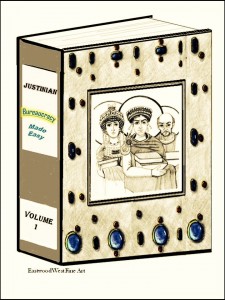November 16, 534: On The Best Seller’s List
What did the Byzantines do for fun? The eunuchs certainly indulged in wishful thinking, and everyone loved debating the punctuation of the Nicene Creed. But for pure hilarity the medieval Greeks had their own version of MadLibs: the Justinian Code.
The Emperor Justinian was a workaholic and he expected everyone else to be one, too. The legal department was ordered to compile 400 years of imperial edicts and publish them in one handy reference. Tactfully named the Justinian Code, it was a best seller. Every Byzantine bureaucrat bought a copy, if only to learn what laws he would have broken by not buying it.
Now the Byzantine magistrate knew all the legal precedents for judging a merchant who shortweighted anchovies on St. Halitosia’s Day. (That would be the St. Halitosia of Cappodocia, not the one of Epirus.) According to the Code, the correct punishment would be amputation of the right side of the nose. Furthermore, the Code would establish the cost of the surgery. If the amputation was performed by an in-network torturer, the government would cover the cost–after the victim’s initial co-payment. The government would cover only fifty percent of the cost for an out-of-network torturer.
Finally, establishing the definitive standard for government bureaucracy and human resource departments, the Code was in Latin and its audience read Greek.
November 16, 1491: Enhanced Interrogations
Waterboarding works. Without its stimulating edification, Benito Garcia might never have realized that he was the leader of a Jewish conspiracy to murder Christian children and seize control of Spain. Until June 1490 Senor Garcia may have been under the impression that he was only an itinerant woolcomber. His education began with a robbery by some laudably pious thieves. As they ransacked the wayfarer’s possessions, they found a morsel of bread resembling a sacramental wafer. Had Garcia stolen it from a church in order to perform some evil Jewish ritual on the sanctified carbohydrate? The thieves decided to turn Garcia over to the authorities; and the authorities saw only the heresy rather than the irony. Furthermore, if this was heresy, then it was a matter for the Inquisition.
Initially, Garcia seemed unaware of his obvious guilt. Flogging failed to enlighten him. Then the rack also proved uninstructive. However, the water torture convinced Garcia of his guilt. Of course, Garcia’s crime required accomplices; he was persuaded to come up with four names. These people, once they had their tutorials, also had some remarkable self-realizations. More culprits were named and more crimes were confessed. After an edifying soaking, and in hopes of avoiding another, a Yuce Franco admitted to killing a Christian child near La Guardia, Castille as part of a magic spell that would make Spain’s Christians disappear.
Franco’s sensational admission required everyone to be interrogated again. They were persuaded to confess the murder, but no one could agree on the details. They did not concur on the name or description of the child, the site of the crime, or where the body was placed. Even the Spanish civil authorities were uncooperative; they failed to find any reports of a missing child in or near La Guardia. However, the Inquisition decided that those details were irrelevant. The confessions sufficed and could be taken as gospel.
On this day in 1491 Benito Garcia, Yuce Franco, and three others were burned at the stake. So were three corpses of men who had failed to survive until their execution. The trial and auto da fe occurred in La Guardia, but the accusations were known throughout Spain, spread and incited by the Inquisition. Expounding this “conspiracy” as proof of the Jews’ danger and enmity, Grand Inquisitor Tomas de Torquemada demanded the Jews’ expulsion from Spain. Isabella was gullible enough to agree. Ferdinand was craven enough to concur.
So, as Torquemada would have told you, waterboarding works.
 What did the Byzantines do for fun? The eunuchs certainly indulged in wishful thinking, and everyone loved debating the correct prepositions in defining the Holy Trinity. But for pure hilarity the medieval Greeks had their own version of MadLibs: the Justinian Code.
What did the Byzantines do for fun? The eunuchs certainly indulged in wishful thinking, and everyone loved debating the correct prepositions in defining the Holy Trinity. But for pure hilarity the medieval Greeks had their own version of MadLibs: the Justinian Code.